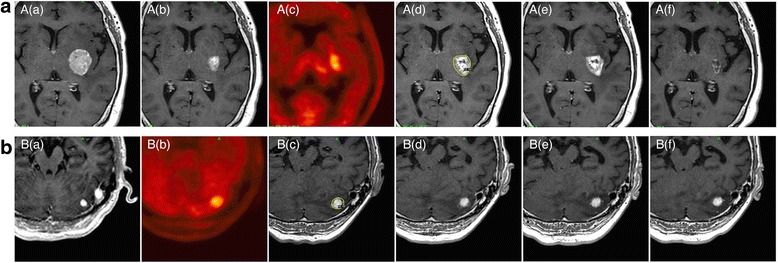Fig. 2.

Serial axial Gd-enhanced MR images and MET-PET images of two cases in which MET-PET diagnoses could not be confirmed even with sufficient follow-up after salvage treatment. a: 60s–year-old-woman with multiple brain metastases from breast cancer. (a) Gd-enhanced MR image obtained at the time of the initial SRS. (b) Gd-enhanced MR image obtained three months after SRS. (c) MET-PET image obtained 8 months after initial SRS. The LNR was 1.67. (d) Gd-enhanced MR image obtained at the time of the second SRS. The yellow line represents the prescription isodose volumes (12 Gy at 50%). (e) Gd-enhanced MR image obtained 1 month after the second SRS before BV rescue. Re-irradiation caused neurological worsening and perifocal oedema. (f) Latest follow-up Gd-enhanced MR image obtained 20 months after MET-PET. Repeat BV therapy resulted in symptomatic relief and radiological stabilisation. b: 70s–year-old-man with solitary cerebellar metastasis from gastric cancer. (a) Gd-enhanced MR image obtained at the time of the initial SRS. (b) MET-PET image obtained 19 months after the initial SRS. The LNR was 1.50. (c) Gd-enhanced MR image obtained at the time of the second SRS. The yellow line represents the prescription isodose volumes (22 Gy at 50%). (d) Gd-enhanced MR image obtained 12 months after the second SRS. Re-irradiation caused cerebellar ataxia, requiring temporary conservative treatment with oral steroids. (e) Gd-enhanced MR image obtained 26 months after the second SRS. (f) Latest follow-up Gd-enhanced MR image obtained 36 months after MET-PET. Symptomatic relief and radiological stabilisation were maintained during long-term observation
